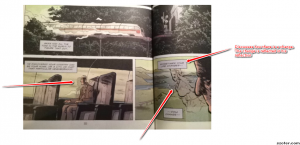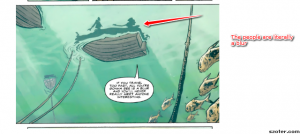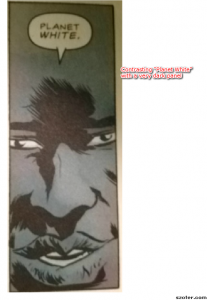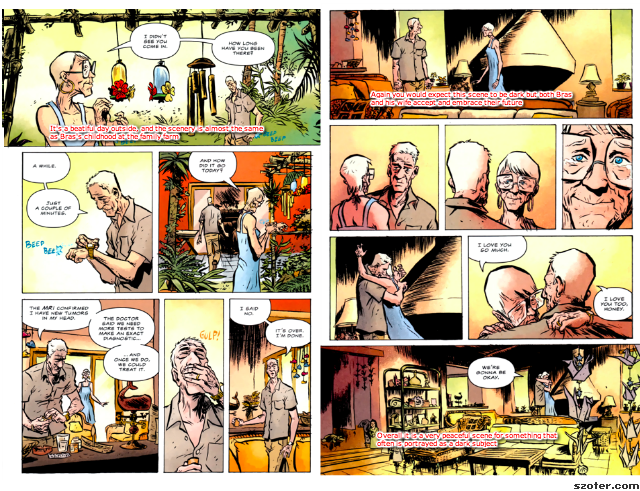Graphic novels act as a medium that can portray stories in way that conventional novels cannot. The artistry of the pictures do the job that descriptive writing would do—setting the mood, invoking emotion, and revealing interactions between characters and delving deeper into the characters themselves. However, with the graphic novel approach, the reader is able to connect on a different level with the character. Viewing the scenes rather than reading them allows for a more perceptive experience—you are still employing your imagination, yet are being guided by the colors and positions of images on the page. Much like how word choice plays a role in interpretation of a literature work, placement and artistic decisions play a major role in the emotions that are evoked by the graphics. It is not to say that one medium is necessarily better than another, but rather they provide different experiences. For a novel such as Moon and Ba’s Daytripper, a graphic novel was a far more effective medium than a conventional novel. The images make it easier for the reader to follow the confusing timeline of the Bras de Oliva Domingos’ life, while also allowing us to get to know him without his life being laid out for us in a description. Most of the text is dialogue or thoughts, not background presented by a narrator. As we travel alongside Bras, we get to know him through his actions and by visually experiencing his emotions through the colors and facial expressions. Through this method, we are able to relate to Bras on an intimate, yet detached level, one that allows us to connect the attributes of his life to our own. We feel for Bras, yet we are also able to relate the different stages of his life—his hardships, his defining moments, and his emotions—to our own. We are able to do this because we are following him along through his life and know just as much as he does about what is going to happen next. We can die at any moment—and it is through the uncertainty and twists of Bras life that we are able to experience this concept. We don’t need to be told things through descriptions—we are guided through the journey. Moon and Ba tactfully produce certain emotions through their artistry—from subliminal clues that we may not even pick up on and the relative colors of the background to the body language and facial expressions of the characters. Similarly, the “silence” brought on by the minimal dialogue used works powerfully to form relationships between characters and between the reader and the character. Through this silence we are able to feel the characters, and it is through this interaction that we learn about who they are, what they desire, how they perceive the world. We learn more from these still images, there frames shots of life, than we could from spoken word or physical description. They say a picture’s worth a thousand words, and Moon and Ba’s novel couldn’t have depicted this any better.

Tag: ba and moon
Being able to read Daytripper for a class, was to me, a dream come true because it has allowed me to look at a media I enjoy academically. In class we discussed the advantages of using a graphic novel as a medium, and I believe that one was not discussed too extensively. This advantage being how images can be used to reflect or contrast the text of the story. Image 1 demonstrates the image literally reflecting onto the text (232-233). Here the author discusses how sometimes changes in your life change you. As the panel crosses the page, the reflection of Brás appears to get older. This may symbolize that change experienced by Brás between chapters 1 in 10 on his opinion on family. The novel begins with a negative connotation with Brás describing how “we don’t get to choose our family” (29). As things change in his life, his opinion changes to a more positive description of how “we carry our family inside of us- it’s who we are” (239). Next, in image two (page 89) the reader finds that the image acts as a symbol of the author’s word choice. The people outside, are being blocked by a physical barrier. The people outside the barrier are darker and represent the dead, while in the light are the living trying to “block it all out” (89). Another visualization appears in image 3 (44). The Brazilian woman talks about how traveling too fast can result in seeing life as a blur. In the image, Brás and the woman are both blurred images, suggesting that Brás’ set itinerary has resulted in him rushing through life. The final image is an example of the contrast. Jorge is depicted saying “Planet White” which is juxtaposed by a dark panel frame (39). Through these images, it can be understood how the graphic novels used images to compliment and improve the messages delivered through the story of Brás, and how the graphic novel acts as an ideal medium for Daytripper.
Before reading Daytripper, I had never read a graphic novel or even stumbled across one, for that matter. So before delving into Daytripper, I really had no idea what to expect as the only conception I had of graphic novels and comics pertained to super-heros fighting evil. Never did I imagine that this graphic novel would move me in such a profound way. The novel itself is structured in a very unique way. Initially, each ‘chapter’ or installment of the book was released separately to the public before being collected together to create the graphic novel. The story follows an aspiring author named Bras de Oliva Domingos, the son of a famous Brazillian writer, who writes obituaries for a Brazillian newspaper. Initially Bras feels the burden that comes with his fathers fame and often resents him for it. In the first installment of this novel, Bras eases himself with a drink at a local bar before attending a gala celebrating his fathers achievements. All seems well, before a drastic plot twist takes Bras life at the hands of an armed robber. Right off the bat, this novel causes an uneasy feeling in the reader, but that is what makes it beautiful. Each installment that follows, continues to explain more of the realities that may have been Bras’s life, with his death ending each chapter. Just as the reader starts to become attached to the young writer who’s trying to figure out his life, he is taken away by the hands of death. This unique plot, elucidates far more than just the life of Bra’s.
Death is often a subject that most societies look down upon. A topic that is correlated to darkness, pain, and melancholy. It is a subject most people chose to avoid until it directly effects them. Why is that the case? Why should we shun the idea of death and do everything in our power to prevent it when simply stated, death is part of life. If there are two things that are certain in this world it is that there is life, and life is followed by death. Death is inevitable and necessary to facilitate future life in all realms from humans to plants to single-celled organisms. Death is simply part of living and will be part of everyones life. That idea is what makes Daytripper beautiful. Death is often portrayed as a very saddening event and something people try to avoid, but in the case of Bras, death reaches him at sad times in his life but also at happy times. We may have peaks and troughs in our lives, but together they constitute to our experience on earth and can be ended at any moment. The story of Bras in Daytripper, takes us through these highs and lows of his life and with his death, makes us appreciate these moments in our own lives even more. Through heartbreak, love, success, and pain, we follow Bras de Oliva Domingo’s life and his realization that death will be just a single part of those life experiences, rather than the end. Through heartbreak, love, success, and pain we follow our own lives as well, and hopefully come to a similar conclusion.
This idea of the acceptance of death as part of life can be vividly seen towards the final chapters of the novel, as shown in the annotated pages below.







